Wormholes
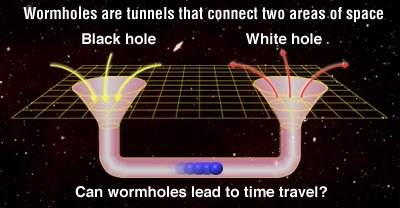
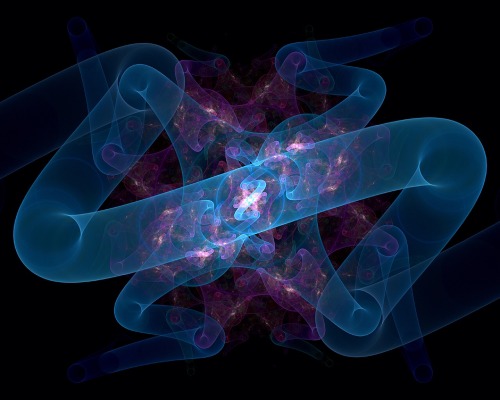
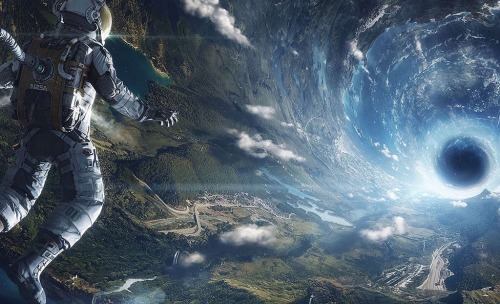
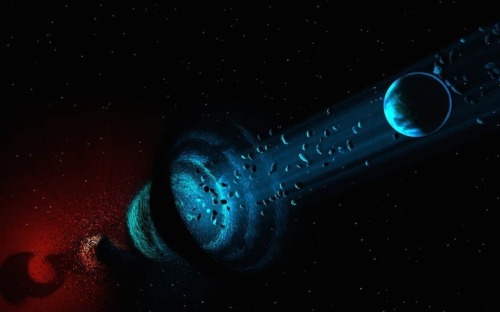
Wormholes
Also known as Einstein-Rosen Bridges are theoretically possible going by Einstein’s theory, and equations of general relativity. Basically wormholes take advantage of our 3 dimensional space and are able to “bend” it. Picture a sheet of paper; now put two circular holes on each end of that sheet of paper. Normally the quickest way to join one point to the other would be to draw a straight line between them. Now instead, you could fold the piece of paper so each hole is touching meaning that there is no longer any distance between them. This is an analogy of how a wormhole works except instead of a circular hole on a 2D plane, the entry and exit points of an Einstein-Rosen bridge can be visualised as spheres in a 3D space.
While the theory of general relativity allows the existence of wormholes, we have not yet found physical evidence. The first wormhole solution discovered was the Schwarzschild wormhole presented in the Schwarzschild metric describing an eternal black hole. However this is not stable enough and would collapse before anything could cross from one end to the other. Traversable wormholes could exist of there was a form of exotic matter with a negative energy to stabilise them.
The Casmir effect shows that quantum field theory allows the energy density in some space to be relatively lower than the ordinary vacuum of space. A lot of physicists (like Stephen Hawking) use this to argue that it is possible to stabilise a traversable wormhole. However there are no known natural processes that would cause a traversable wormhole to stabilise.
The quantum foam hypothesis can be used to suggest the spontaneous appearance of tiny black holes at the Planck scale. Stable versions of these tiny wormholes have been suggested as dark matter candidates. It is also possible that one of these wormholes opened into a previously empty space from another universe, held open by a cosmic string (1D string) with a negative mass then it could be inflated to a macroscopic size by cosmic inflation. Is it possible this happened at the start of the Big Bang?
More Posts from Space-m17-blog and Others

Cosmic lighthouse known as the Egg Nebula, which lies around 3000 light-years from Earth. The image, taken with the NASA/ESA Hubble Space Telescope, has captured a brief but dramatic phase in the life of a Sun-like star.
js

This Week’s Astronomy News:
48 Galaxies Found: http://ift.tt/1NSd8Rk How Galaxies Evolve: http://ift.tt/1JwtT1n Alien Life: http://ift.tt/1JwtRqe Dark Energy: http://ift.tt/1NSd6ZJ Black Hole: http://ift.tt/1NSd6ZL Twin Jet: http://ift.tt/1NSd8Rn

New Horizons: Enhanced false-color mosaic of Pluto, July 14th 2015
New Horizons scientists use enhanced color images to detect differences in the composition and texture of Pluto’s surface. When close-up images are combined with color data from the Ralph instrument, it paints a new and surprising portrait of the dwarf planet. The “heart of the heart,” Sputnik Planum, is suggestive of a source region of ices. The two bluish-white “lobes” that extend to the southwest and northeast of the “heart” may represent exotic ices being transported away from Sputnik Planum. Four images from New Horizons’ Long Range Reconnaissance Imager (LORRI) were combined with color data from the Ralph instrument to create this enhanced color global view. The images, taken when the spacecraft was 280,000 miles (450,000 kilometers) away, show features as small as 1.4 miles (2.2 kilometers).
Image Credit: NASA/JHUAPL/SwRI
An Exo-What...?

Simply put, an exoplanet is a planet that orbits another star. That said, just because a planet orbits a star (like Earth) does not mean that it is automatically stable for life. The planet must be within the habitable zone, which is the area around a star in which water has the potential to be liquid…aka not so close that all the water would evaporate, and not too far away where all the water would freeze.
Recently, with the help of our Kepler spacecraft, scientists have discovered the most Earth-like exoplanet ever, Kepler-452b. Pretty cool! This chart shows 12 other exoplanet discoveries that are less than twice the size of Earth, and live in the habitable zone of their host star. Kepler-452b is special because all previous findings have orbited stars that are smaller and cooler than Earth’s.

You may be thinking, “Okay, so what? There’s an Earth-like planet that spins around a similar sized sun.” Well, Kepler-452b orbits its sun at nearly the same distance from its star as Earth does from our sun, which means that conditions on the plant could be similar to those here on Earth!

We can already guess your next question…”When are we going to Kepler-452b?!” Well, this planet is located in the constellation Cygnus which is 1,400 light-years away, so not anytime soon. However, our Kepler spacecraft continues to search for Earth-like exoplanets and gather important scientific information about them.

Hubble Peers into the Heart of a Galactic Maelstrom
This NASA/ESA Hubble Space Telescope image shows Messier 96, a spiral galaxy just over 35 million light-years away in the constellation of Leo (The Lion). It is the nearest group containing both bright spirals and a bright elliptical galaxy (Messier 105).
September 04, 2015
One of the characteristics of successful scientists is having courage. Once you get your courage up and believe that you can do important problems, then you can. If you think you can’t, almost surely you are not going to. Courage is one of the things that Shannon had supremely. You have only to think of his major theorem. He wants to create a method of coding, but he doesn’t know what to do so he makes a random code. Then he is stuck. And then he asks the impossible question, “What would the average random code do?” He then proves that the average code is arbitrarily good, and that therefore there must be at least one good code. Who but a man of infinite courage could have dared to think those thoughts? That is the characteristic of great scientists; they have courage. They will go forward under incredible circumstances; they think and continue to think.
“You and Your Research,” Dr. Richard W. Hamming of Bell Labs (via ryanandmath)
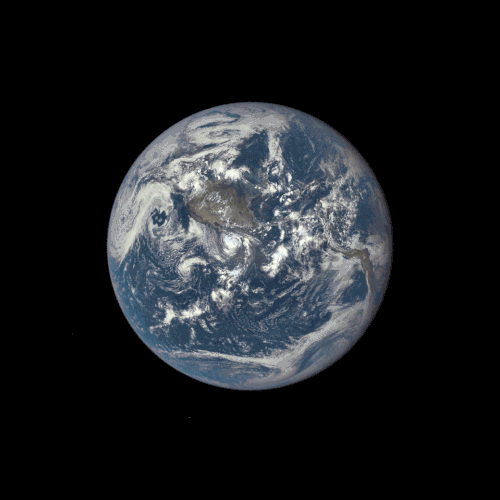
Welcome to the new, official NASA Tumblr. We’re going to be giving you a regular dose of space here. Follow along and join us as we share information, images and video about our mission of exploration and discovery. First up, check out the moon photobombing Earth in this new animated gif. The far side of the moon, illuminated by the sun, is seen as it crosses between our ‘EPIC’ camera on the Deep Space Climate Observatory (DSCOVR) satellite, and the Earth - one million miles away. Check it out: http://go.nasa.gov/1Dq0IO9
National Aviation Day!

Today, August 19, is National Aviation Day! You might wonder why we’re celebrating National Aviation Day, let us tell you…
First, did you know that EVERY U.S. commercial aircraft and every U.S. air traffic control tower has NASA-developed technology on board? It’s true! Here at NASA, we’re invested in aeronautic research. Today’s air transportation system is an integral part of the U.S. and global economies.
It’s the primary mechanism for connecting countries across the world through moving people, as well as goods and services. You feel the impacts of aviation and the air transportation system everyday. Just about every product produced and purchased today has been touched by aviation in some way. Aircraft transport 17.7 billion tons of freight every year. While you may not have flown today, something you needed did.

Our aviation experts are dedicated to improving the design of airplanes so they’re more Earth friendly – less fuel use, lower pollution, less noise around airports. We also work with the Federal Aviation Administration to provide new tools to air traffic controllers for improving efficiency and reducing delays.
So, celebrate National Aviation Day with us! Spread Your Wings, take a photo, post it today and tag #SpreadYourWings and/or #NationalAviationDay. We may even pick your photo to highlight on our NASA web page!

(3 June 1965) — Overall view of the Mission Control Center in Houston, Texas, during the early hours of the Gemini-Titan 4 spaceflight. Photo credit: NASA






Full project here: https://www.behance.net/louisdazy
-
 oldanddilis reblogged this · 5 years ago
oldanddilis reblogged this · 5 years ago -
 oldanddilis reblogged this · 5 years ago
oldanddilis reblogged this · 5 years ago -
 kappa14 liked this · 6 years ago
kappa14 liked this · 6 years ago -
 kirby58-blog liked this · 6 years ago
kirby58-blog liked this · 6 years ago -
 illuminati-duh liked this · 7 years ago
illuminati-duh liked this · 7 years ago -
 galand20 liked this · 7 years ago
galand20 liked this · 7 years ago -
 marvi-jude94 liked this · 7 years ago
marvi-jude94 liked this · 7 years ago -
 m3mentomor1 reblogged this · 7 years ago
m3mentomor1 reblogged this · 7 years ago -
 symbioticsimplicity liked this · 7 years ago
symbioticsimplicity liked this · 7 years ago -
 jasminegokuko liked this · 7 years ago
jasminegokuko liked this · 7 years ago -
 eynrbrzm liked this · 7 years ago
eynrbrzm liked this · 7 years ago -
 white-trash-balling liked this · 7 years ago
white-trash-balling liked this · 7 years ago -
 sucio-1-blog liked this · 8 years ago
sucio-1-blog liked this · 8 years ago -
 my-so-called-euphoria liked this · 8 years ago
my-so-called-euphoria liked this · 8 years ago -
 sleepysneezeydopeydoc-blog reblogged this · 8 years ago
sleepysneezeydopeydoc-blog reblogged this · 8 years ago -
 sleepysneezeydopeydoc-blog reblogged this · 8 years ago
sleepysneezeydopeydoc-blog reblogged this · 8 years ago -
 sleepysneezeydopeydoc-blog liked this · 8 years ago
sleepysneezeydopeydoc-blog liked this · 8 years ago -
 drzaa liked this · 8 years ago
drzaa liked this · 8 years ago -
 triskyson liked this · 8 years ago
triskyson liked this · 8 years ago -
 echoing-oceans liked this · 8 years ago
echoing-oceans liked this · 8 years ago -
 spadeskeletalspade reblogged this · 8 years ago
spadeskeletalspade reblogged this · 8 years ago -
 freakqncy-blog reblogged this · 8 years ago
freakqncy-blog reblogged this · 8 years ago -
 licomming-blog liked this · 8 years ago
licomming-blog liked this · 8 years ago -
 freakqncy-blog liked this · 8 years ago
freakqncy-blog liked this · 8 years ago -
 todaysteaparty liked this · 8 years ago
todaysteaparty liked this · 8 years ago -
 tifflovespandas-blog liked this · 8 years ago
tifflovespandas-blog liked this · 8 years ago
I love space. I've been to space camp in Huntsville Alabama and I am planning on going every summer. I look forward to be an astronaut for nasa on the sls that is planned to be launched 2018. And the manned mission 2030. So yeah I won't let anything get in my way.
138 posts